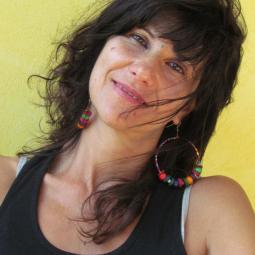claudia botta
Artist, Bologna, Italy, joined 11 years ago
In-naturale is based on the manipulation and modification of real flowers, to which I add or substitute some parts through the insertion of objects that might be completely alien to nature: the result is, thus, photographed in order to document and fix in time such microsculptures. The modifications adopted are often imperceptible at first sight, but a caption points out and reveals all the “ingredients” which have been used, and this forces the spectator into a more careful observation. At this stage, it is clear that a counterfeit of the flower exists, given by the use of artificial materials, which are perceived as natural despite the photographic image being considerably enlarged. This gives rise to a feeling of astonishment, as well as discomfort facing the loss, realizing to what degree nature has been parted, to the point of living it superficially, taking it for granted, no longer distinguishing what is real from what is fictitious, what is mutable from what is inert.
At the beginning, although flowers intrigued me, I was somewhat reluctant to consider them a possible subject, as they appeared to me a little too placating, too feminine, and tooobvious as well. In spite of these considerations, I was continuously attracted by them like an insect, mostly because ofthe perfect variety of their shapes and the strength of their
colours. Furthermore I said to myself that the care for nature considered in all its details and in its infinite richness and beauty, belongs naturally to the female world, in what women have a real and tangible relation, a constant daily frequentation, with the produce of the soil. As a matter of fact, the most distinguished still lives of the seventeenth century, are works of women painters such as Fede Galizia, Louise Moillon, and Clara Peters, who soon discovered how the new genre was suited to their social status. Moreover, I could not deny the interesting and undisputable symbolic value of flowers, as theyhave always been related to the concept of impermanence of the existence. This is how I began to observe them and study them in literature, art, tradition, architecture, and in the decorative arts.
While, animated by an ecologic vein, I was making large sugar flowers for bees threatened with extinction to station on, I slowly began to consider real flowers, firstly dried and then
freshly cut ones. I soon realized how well suited they were to represent the theme of the decay of our society, in a softened and not necessarily lacerating and dramatic way. Being a flower the symbol of incorrupt purity, simplicity and naturalness par excellence, it was perfectly suited for my study, an optimal subject for an illusory game, the unsuspected transfer of an artifice, of a counterfeiting. Also, because it is beautiful and captivating. Modifying some of its parts linked my work to the desire of power typical of mankind and to a series of expedients, which the system of profits applies to its products.
Although I prefer the symbolic aspect of painting, I chose photography because it represents reality more faithfully, giving to a still life a further sense of death, a theme that I have always treated throughout my entire artistic career.
Photography also allows me to calibrate the quality of the image through a laboratory-like approach, giving it a not too over-refined appearance, and to remain within a conceptual
context, where the project and the object are more important than the aesthetic appearance.
Thus, regardless of which discipline is superior to the other, photography or painting, I choose an intermediate direction.
Firstly, I proceed like a plastic artist, modelling, painting, merging the different materials that I need so as to obtain a certain effect, or a petal that resembles a real one. Then, like a photographer, I take a photo to objectify my creation, making use of the presumed fidelity of photography to immortalize an object realistically. The reconstruction of a pistil or a part of a flower so that they appear absolutely credible, belongs maybe the “ubris” of men who aim to substitute themselves to God, while celebrating him through their work, and it is the artist’s claim to recreate what was created. Nature is beautiful when it has the appearances of art, and art itself cannot be regarded as beautiful unless we consider it as nature, aware of the fact that it is still art (Kant).
When I attempt these mutations, adjust a corolla, add a thorn, I am as thrilled as if I were a plastic surgeon, and I feel the absurd exaggeration of Lucifer, because of the strong sexual force that all flowers hold.
In my contaminations I never aimed at reaching the level of bio-artists, whose actions begin at the origins, modifying the DNA of some vegetables to transform their appearances, although their research clearly fascinates me. I would like to study a kind of sophistication that is closer to the one we encounter every day in the food and materials that we touch. This is why I use glues, enamels, preservatives, wax, plastics, chemical agents, cosmetics, paints, medicines, organic elements, vegetal or animal parts etc… I photograph my modified flowers even when they wither, documenting how artificial parts remain intact while all the rest fades, which inevitably reminds me of prosthesis in corpses,
the undamaged artificial limbs on decomposed bodies, and all breast implants which will outlive the vanishing beauty. Transforming flowers and creating false vegetables has allowed me to work in a recoiling dimension focused on details, and has blessed me with a contemplative as well as a pulsing contact.
Who knows, maybe one day I may think of writing under each one of these pieces of work: “Ceci n’est pas une fleur”…
News
celeste,







